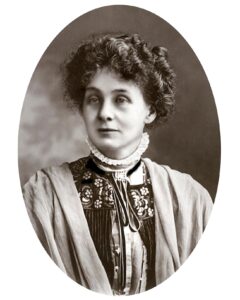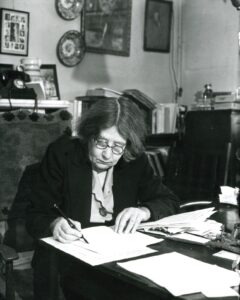Leading historian AMANDA FOREMAN explains why the Queen was a true feminist icon who changed the world for millions of women – in very surprising ways.
September 17, 2022
Ask someone for the name of a famous feminist and no doubt you’ll get one of a few prominent women batted back to you. Germaine Greer. Gloria Steinem. Hillary Clinton. But Elizabeth Windsor? That would be a no. She looked the opposite of today’s powerful women with her knee-length tweeds and distinctly unfashionable court shoes.
I, though, argue differently. As a historian with a particular interest in female power, I believe one thing above all puts the Queen in a special category of achievement. Not the length of her reign. Not even her link to the courageous wartime generation. No, it is her global impact on the cause of gender equality that should be remembered, all without donning a miniskirt or wailing MeToo. All without spilling emotions, making herself a victim or hiding the effects of age and motherhood.
I believe the Queen is the ultimate feminist icon of the 20th Century, more a symbol of women’s progress in this century than other icons like Madonna or Beyoncé could dream of. Females everywhere, particularly those past menopause, have much to thank her for.
But when it has been previously suggested the Queen was a feminist, or that women should celebrate her life, critics have bitten back sharply.
In 2019 Olivia Colman, who portrayed the Queen in the Netflix drama The Crown, provoked equal cheers and jeers for describing her as ‘the ultimate feminist’. A few years before, Woman’s Hour chief presenter Emma Barnett had her intellectual credentials questioned for calling the Queen a ‘feminist icon’.
They justified the view for different reasons. For Colman, it was because the Queen had shown a wife could assume a man’s role while retaining her femininity. The argument went in reverse for Barnett: the Queen had shown her gender was ‘irrelevant to her capacity to do her job’.
Yet no King would ever have his masculinity and the definition of manhood so conflated in the same way. It’s doubtful anyone will question whether King Charles defines the essence of what it is to be a man.
In the midst of all the grief for the Queen, we should remember at the beginning of her reign Elizabeth’s potential power to effect change provoked as much unease as it did anticipation. In a patriarchal world, female empowerment is a force to fear. After all, we never talk about ‘male empowerment’, do we?
Our two other long-lived queens, Elizabeth I and Victoria, had the same scrutiny. Foreign affairs, great questions of state, probity in government, what did that matter compared to the burning issue of what it meant to have a woman placed above the heads of men?
It was not easy for Elizabeth II to escape from under the shadow of Queen Victoria, the figurative mother of the nation.
Initially, it wasn’t even clear she wanted to. Though the command for brides to obey their husbands had not been part of the Book of Common Prayer since 1928, Elizabeth included it in her wedding vows.
Aged 25, she was a mother-of-two when she made her accession speech before the Privy Council. Accompanied by her husband, Elizabeth looked even younger than her years, surrounded by a roomful of mostly old men. But after the Privy Council meeting, the comparisons with Victoria stopped. And you can begin to see her innate feminism come to the fore. Elizabeth did not lose her self-confidence in between pregnancies and pass over the red boxes or deputise Philip to meet her Ministers. Far from it. She took on the role of sovereign and Philip accepted his as the world’s most famous house-husband.
In reality, there were few actions or speeches of the Queen’s that could be classed as declaratively feminist – such as the time she drove Crown Prince Abdullah of Saudi Arabia around Balmoral in her Land Rover when Saudi women were forbidden to drive, going at such breakneck speed while chatting that the Prince begged her to slow down.
Or her few comments about the work of the WI, or the potential to be tapped if only society can ‘find ways to allow girls and women to play their full part’.
No, instead of examples like these, the Queen was a feminist for reasons most women can instantly relate to: first, she established clear boundaries between the demands of her job and those of her family.
Society still expects wives will drop everything for the family, no matter how consuming their careers, so husbands can go to work. Not once did the Queen say or imply she ought to shift her weekly audience with the Prime Minister, or cancel the ribbon-cutting of a hospital because of some domestic concern.
Second, society judges working mothers much more harshly than working fathers, giving the latter a free pass if their job is important enough but condemning the former as a terrible person if her children don’t turn out to be outstanding successes. The Queen’s fitness as sovereign has never been tied to her fitness as a mother. Although she always made her family a part of her life, Elizabeth did not allow it to define her as Victoria did.
Third, society makes middle- aged women feel that they are invisible. Their opinions stop mattering, contributions don’t count and their bodies, according to fashion designers, don’t exist. Whispers that the Queen ought to abdicate began in her 50s. By 1977, her Silver Jubilee, critics wondered what she was good for now her youth and figure were in the rear-view mirror.
In answer, she embodied the reverse of Invisible Woman Syndrome. By refusing to countenance abdication, she showed what a working woman looks like past menopause. Rather than shrinking, she revved up a gear and demonstrated a woman’s age has no bearing on her agency and authority.
Her fabulous colour sense and ability to match dresses to the mood excited intense interest – but this didn’t make her a feminist icon. In an age when a woman’s sexiness is her currency, and empowerment judged by how much of her body she exposes, she refused to make any concessions to fashion.
This was a confident femininity, an inner feminism based on absolute assuredness of who she was and why she mattered. For over five decades, the Queen showed what strength and purpose look like on the body of an older woman.
The next three generations of monarchs are due to be Kings. To some extent, the old way of doing things will return. So, it is up to us to honour Queen Elizabeth’s memory by following her example.
She tore up the rule book on gender roles without society falling apart or families breaking down. Despite heavy restrictions on what she could do as a woman let alone a Queen, she forged her own path – and invited the rest of us to follow.








